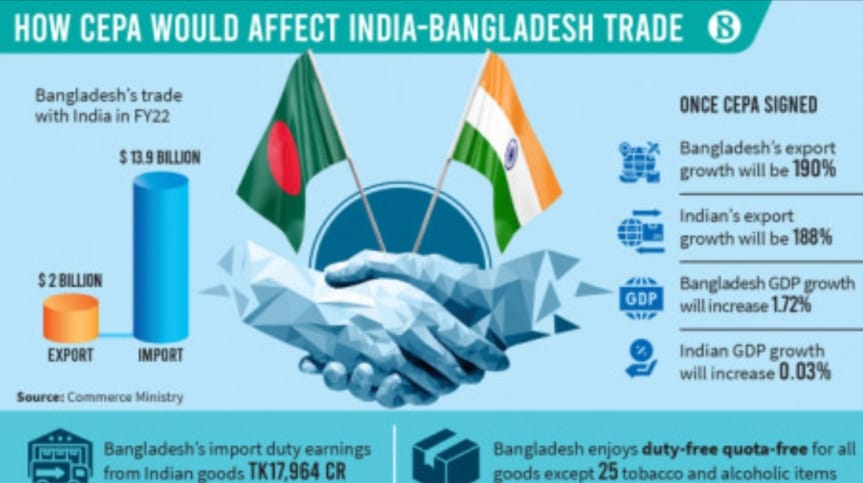PM approved the proposal to start the negotiation to sign the (CEPA)
SUMMARY
According to the Indian Prime Minister, talks on a bilateral Comprehensive Economic Partnership Agreement between India and Bangladesh would shortly begin (CEPA). The main goal of the CEPA is to close the trade imbalance between the two countries, with a focus on trade in goods, services, and investment.
CONTENT
On August 22nd, given that both sides agreed to a joint review of the proposed, India intends to begin a conversation with Bangladesh to sign a Comprehensive Economic Partnership Agreement (CEPA) as soon as possible, preferably next month.
For the very first time, Bangladesh will officially begin negotiations to sign a Free Trade Agreement (FTA) with a country. A few other countries, including China and Japan, have made proposals for free trade agreements with Bangladesh, but everything is now in an evaluation phase. The CEPA agreement is a bit different from Free Trade Agreements, as, it covers many topics, including trade and services, investment, intellectual property rights and e-commerce.
According to the summary of what Bangladesh and India will get from the trade agreement, after it is signed, Bangladesh’s export earnings will skyrocket by 190% compared to India’s 188%.
Prime Minister Sheikh Hasina visits New Delhi in the first week of September, Indian Commerce Secretary BVR Subrahmanyam recently brought up this proposal to Bangladesh High Commissioner in New Delhi Muhammad Imran.
According to reports, the Indian Commerce Secretary said that the commencement of the FTA (CEPA) negotiations might be specified in the joint statement of the VVIP visit.
On the 6th of September, after meeting with Prime Minister Sheikh Hasina, who is in India for a four-day visit, PM Modi announced that the two countries have also decided to expand their collaboration in areas including IT, space, and nuclear energy. India aims to start negotiations to sign a Comprehensive Economic Partnership Agreement (CEPA) with Bangladesh.
The high commission informed the Ministry of Foreign Affairs in Dhaka, emphasizing that CEPA negotiations should be conducted in a way that would give Bangladesh an advantage over India.
According to the report of the joint feasibility study by Dhaka and Delhi, if the trade agreement is signed, Bangladesh’s export revenues can go up by $3-5 billion and India’s by $4-10 billion surrounded by the next seven to ten years. Therefore, new investment ways also will open up for both countries due to the proposed CEPA.
Bangladesh and India have discussed the possibilities before signing the CEPA and Signing a CEPA agreement to enhance bilateral trade and overall cooperation at a trade minister-level meeting in 2018. Also, the trade ministers of the two countries are in the agreement to conduct a joint feasibility study on signing the CEPA agreement. The Centre for Regional Trade of India and Bangladesh Foreign Trade Institute (BFTI) conjointly performed the joint Feasibility study and submitted a report to the Ministry of Commerce (MOC).
Moreover, according to a joint Dhaka-Delhi feasibility study, the gross domestic product (GDP) of Bangladesh and India will grow by 1.72% and 0.03%. The Ministry of Commerce said, signing such an agreement with trading partners brings positive outcomes, however, there is a probability of a drop in revenue. In FY22, Bangladesh generated 17,964 tk. crore against imports of 1,44,160 tk. Crore. If the CEPA agreement is signed, import revenues will be suddenly reduced in forms, he noted.
The ministry has also added, however, in other aspects of economic development, including services and investments, are included in the CEPA agreement, there is expected to be a positive impact on the overall economy if the agreement is signed. In the last fiscal year for the first time in Bangladesh exports to India climbed to almost US$2 billion, while imports totaled around US$14.billion.
It advised that the CEPA negotiations with India might begin shortly to perform the facilities and benefit Bangladesh can get under the South Asian trade space (SAFTA) deals. Almost twenty-five tobacco and alcohol products of Bangladesh are entitled to duty- and quota-free market access facility to India because of a least developed country (LDC). If Bangladesh becomes a developing country, such facilities will no longer be available in the market after 2026. Thus, there is a risk of negative effects on exports to India.
According to the ministry, “there are several types of non-tariff barriers to exports to India, including the imposition of anti-dumping duty, testing and certification, insufficient port infrastructure and restrictions on road and waterway communications. If such obstacles are removed, Bangladesh’s commodity exports have the potential for further growth”
Dr. Mostafa Abid Khan, a foreign policy analyst and trade negotiator, told The Business Standard that “Bangladesh’s aim while the CEPA negotiations should be eligible for duty-free export facilities within the Indian market even after LDC graduation. We should also try and remove non-tariff barriers that are hindering our exports to India,” he said.
Abdul Matlub Ahmad, president of Bangladesh-India Chamber of Commerce and Industries and told TBS if the CEPA agreement is signed, “India has cotton. We are able to do yarns and garments, joint investment moreover as bilateral trade among the two countries will increase” he said.
The abilities and sources of the two countries will be used for every other’s growth and this may benefit both countries. There will be prospects to get many jobs in Bangladesh, he noted.
Prof Mustafizur Rahman, the distinguished fellow of the CPD, earlier told TBS that, the signing of the CEPA agreement will be a win-win position for both countries basically, this deal covers trade, investment, connectivity, logistics, and various policy coordination issues. It is not just tariff adjustment or tariff reduction through the CEPA, “We also must target how we are able to improve our investment in India and attract Indian investors economically. Therefore, it will be great if Bangladesh can get into the Indian market.”
On March 27, 2021, Indian Prime Minister Narendra Modi visited Bangladesh. Bangladesh’s PM and India’s PM have been instructed to complete the joint feasibility study in connection with the signing of CEPA to improve bilateral trade relations.
The director of research of the Centre for Policy Dialogue (CPD), told Financial Express that, India and Bangladesh have earlier settled an assortment of trade and investment deals. There are a few deals that are still in the process of negotiation.
The commerce ministry held an inter-ministerial meeting on the report before the negotiations with India for signing the CEPA with certain precautions. “It is very important to review the documents relating to those negotiations to know India’s priorities, offensive and defensive interests, and establishments operating with negotiations. There are institutional procedures to carry out to implement such agreements,” said Dr. Khondaker Golam Moazzem. He also added that a very competent technical expert team is there to look into the comprehensive deal.
Picture and Article Sources: The Business Standard, The Financial Express, NDTV.


Leave a Reply